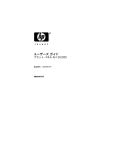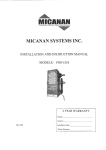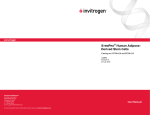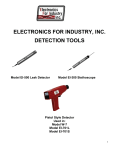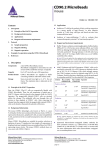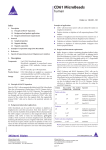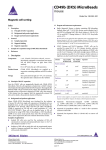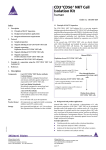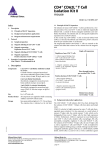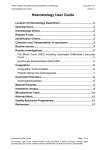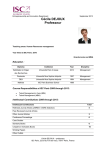Download CD71 MicroBeads - Miltenyi Biotec
Transcript
CD71 MicroBeads human Order No. 130-046-201 Index Examples of applications 1. Description ● Positive selection or depletion of cells expressing human CD71 antigen from peripheral blood mononuclear cells (PBMCs), cord blood, bone marrow or lymphoid tissue. ● Enrichment of fetal erythroid precursor cells, including fetal erythroid precursor cells from maternal PBMCs5 or enrichment of reticulocytes from cord blood. ● Isolation of hematopoietic precursor cells committed to the erythroid lineage (BFU-E) when used in combination with MACS CD34 MultiSort Kit (# 130-056-701). 1.1 Principle of MACS® separation 1.2 Background and product applications 1.3 Reagent and instrument requirements 2. Protocol 2.1 Sample preparation 2.2 Magnetic labeling 2.3 Magnetic separation 3. Example of a separation using CD71 MicroBeads 1.3 Reagent and instrument requirements 4. References ● Buffer (degassed): Prepare a solution containing PBS (phosphate buffered saline) pH 7.2, 0.5% BSA (bovine serum albumin) and 2 mM EDTA by diluting MACS BSA Stock Solution (# 130-091376) 1:20 with autoMACS™ Rinsing Solution (# 130-091-222). Keep buffer cold (4−8 °C). ▲ Note: EDTA can be replaced by other supplements such as anticoagulant citrate dextrose formula-A (ACD-A) or citrate phosphate dextrose (CPD). BSA can be replaced by other proteins such as human serum albumin, human serum or fetal calf serum. Buffers or media containing Ca2+ or Mg2+ are not recommended for use. ● MACS Columns and MACS Separators: CD71+ cells can be enriched by using MS, LS or XS Columns (positive selection). CD71 MicroBeads can be used for depletion of CD71+ cells on LD, CS or D Columns. Cells which strongly express the CD71 antigen can also be depleted using MS, LS or XS Columns. Positive selection or depletion can also be performed by using the autoMACS Separator. 1. Description Components 2 mL CD71 MicroBeads, human: MicroBeads conjugated to monoclonal antihuman CD71 antibodies (isotype: mouse IgG2a; clone: AC108.1). Size For 109 total cells, up to 100 separations. Product format CD71 MicroBeads are supplied as a suspension containing stabilizer and 0.05% sodium azide. Storage Store protected from light at 4−8 °C. Do not freeze. The expiration date is indicated on the vial label. 1.1 Principle of MACS® separation First the CD71+ cells are magnetically labeled with CD71 MicroBeads. Then the cell suspension is loaded onto a MACS® Column which is placed in the magnetic field of a MACS Separator. The magnetically labeled CD71+ cells are retained on the column. The unlabeled cells run through and this cell fraction is depleted of CD71+ cells. After removal of the column from the magnetic field, the magnetically retained CD71+ cells can be eluted as the positively selected cell fraction. Column max. number max. number Separator of labeled cells of total cells Positive selection 2 ×108 MS 107 MiniMACS, OctoMACS, VarioMACS, SuperMACS 140-000-041.05 LS 108 2 ×109 MidiMACS, QuadroMACS, VarioMACS, SuperMACS 1.2 Background and product applications XS 109 2 ×1010 SuperMACS CD71 MicroBeads are developed for the separation of human cells based on the expression of the CD71 antigen. CD71 is the receptor for the iron-binding protein transferrin. Diferric transferrin gains entry into cells by binding to CD71 and receptor-mediated endocytosis. Internalization of CD71-bound transferrin does not result in transferrin degradation. Instead, both the receptor CD71 and the apoprotein ligand, transferrin, are returned to the cell surface with retention of iron within the cell. CD71 is expressed on marrow stromal cells (MSCs) from bone marrow1, on activated T and B lymphocytes, macrophages and all proliferating cells. It is upregulated on lymphocytes during proliferative responses to antigens or mitogens but is not expressed on resting lymphocytes. CD71 is present on reticulocytes and erythroid progenitors, yet it is lost as these differentiate to mature erythrocytes2,3,4. Depletion Miltenyi Biotec GmbH Friedrich-Ebert-Straße 68, 51429 Bergisch Gladbach, Germany Phone +49 2204 8306-0, Fax +49 2204 85197 [email protected] www.miltenyibiotec.com 5 ×108 LD 108 CS 2 ×108 D 109 MidiMACS, QuadroMACS, VarioMACS, SuperMACS VarioMACS, SuperMACS SuperMACS Positive selection or depletion autoMACS 2 ×108 4 ×109 autoMACS ▲ Note: Column adapters are required to insert certain columns into VarioMACS™ Separator or SuperMACS™ Separator. For details, see MACS Separator data sheets. ● (Optional) Fluorochrome-conjugated CD71 antibody for flow cytometric analysis, e.g. CD71-APC (# 130-091-727) or CD71PE (# 130-091-728) Miltenyi Biotec Inc. 2303 Lindbergh Street, Auburn, CA 95602, USA Phone 800 FOR MACS, +1 530 888 8871, Fax +1 530 888 8925 [email protected] page 1/3 Order No. 130-046-201 ● (Optional) PI (propidium iodide) or 7-AAD for flow cytometric exclusion of dead cells. ● (Optional) Pre-Separation Filters (# 130-041-407) to remove cell clumps. 2. Protocol When working with anticoagulated peripheral blood or buffy coat, PBMCs should be isolated by density gradient centrifugation (e.g. Ficoll-Paque™, see "General Protocols" in the User Manuals or visit www.miltenyibiotec.com/protocols). ▲ Note: Remove platelets after density gradient separation: resuspend cell pellet in buffer and centrifuge at 200×g for 10−15 minutes at 20 °C. Carefully remove supernatant. Repeat washing step and carefully remove supernatant. When working with tissues, prepare a single-cell suspension by a standard preparation method (see "General Protocols" in the User Manuals or visit www.miltenyibiotec.com/protocols). ▲ Note: Dead cells may bind non-specifically to MACS MicroBeads. To remove dead cells, we recommend using density gradient centrifugation or the Dead Cell Removal Kit (# 130-090-101). ▲ Work fast, keep cells cold, and use pre-cooled solutions. This will prevent capping of antibodies on the cell surface and non-specific cell labeling. ▲ Volumes for magnetic labeling given below are for up to 107 total cells. When working with fewer than 107 cells, use the same volumes as indicated. When working with higher cell numbers, scale up all reagent volumes and total volumes accordingly (e.g. for 2×107 total cells, use twice the volume of all indicated reagent volumes and total volumes). ▲ For optimal performance it is important to obtain a singlecell suspension before magnetic separation. Pass cells through 30 µm nylon mesh (Pre-Separation Filters # 130-041-407) to remove cell clumps which may clog the column. 2. Centrifuge cell suspension at 300×g for 10 minutes. Pipette off supernatant completely. 3. Resuspend cell pellet in 80 µL of buffer per 107 107 total cells. total cells. 5. Mix well and incubate for 15 minutes at 4−8 °C. ▲ Note: Working on ice may require increased incubation times. Higher temperatures and/or longer incubation times lead to non-specific cell labeling. 6. (Optional) Add staining antibodies, e.g. add 10 µL of CD71-PE (# 130-091-728) or CD71-APC (# 130-091-727), and incubate for 5 minutes at 4−8 °C. 7. Wash cells by adding 1−2 mL of buffer per 107 cells and centrifuge at 300×g for 10 minutes. Pipette off supernatant completely. 8. Resuspend up to 108 cells in 500 µL of buffer. Place column in the magnetic field of a suitable MACS Separator (see "Column data sheets"). 2. Prepare column by rinsing with appropriate amount of buffer: MS: 500 µL LS: 3 mL. 3. Apply cell suspension onto the column. 4. Collect unlabeled cells which pass through and wash column with appropriate amount of buffer. Perform washing steps by adding buffer three times, each time once the column reservoir is empty. MS: 3×500 µL LS: 3×3 mL. Collect total effluent. This is the unlabeled cell fraction. 6. Pipette appropriate amount of buffer onto the column. Immediately flush out fraction with the magnetically labeled cells by firmly applying the plunger supplied with the column. MS: 1 mL LS: 5 mL. ▲ Note: To increase the purity of the magnetically labeled fraction, it can be passed over a new, freshly prepared column. Magnetic separation with XS Columns For instructions on the column assembly and the separation, refer to the "XS Column data sheet". Depletion with LD Columns 1. Place LD Column in the magnetic field of a suitable MACS Separator (see "LD Column data sheet"). 2. Prepare column by rinsing with 2 mL of buffer. Determine cell number. 4. Add 20 µL of CD71 MicroBeads per 1. 5. Remove column from the separator and place it on a suitable collection tube. 2.2 Magnetic labeling 1. ▲ Choose an appropriate MACS Column and MACS Separator according to the number of total cells and the number of CD71+ cells (see table in section 1.3). Magnetic separation with MS or LS Columns 2.1 Sample preparation 2.3 Magnetic separation ▲ Note: For higher cell numbers, scale up buffer volume accordingly. ▲ Note: For depletion with LD Columns, resuspend up to 1.25×108 cells in 500 µL of buffer. 140-000-041.05 9. Proceed to magnetic separation (2.3). 3. Apply cell suspension onto the column. 4. Collect unlabeled cells which pass through and wash column with 2×1 mL of buffer. Collect total effluent. This is the unlabeled cell fraction. Depletion with CS Columns 1. Assemble CS Column and place it in the magnetic field of a suitable MACS Separator (see "CS Column data sheet"). 2. Prepare column by filling and rinsing with 60 mL of buffer. Attach a 22G flow resistor to the 3-way-stopcock of the assembled column (see "CS Column data sheet"). 3. Apply cell suspension onto the column. 4. Collect unlabeled cells which pass through and wash column with 30 mL buffer from the top. Collect total effluent. This is the unlabeled cell fraction. Depletion with D Columns For instructions on column assembly and separation, refer to the "D Column data sheet". This MACS® product is for in vitro research use only and not for diagnostic or therapeutic procedures. page 2/3 Order No. 130-046-201 Magnetic separation with the autoMACS™ Separator 4. References ▲ Refer to the "autoMACS™ User Manual" for instructions on how to use the autoMACS Separator. 1. Pittenger MF, Mackay AM, Bekc SC, et al. (1999) Multilineage potential of adult human mesenchymal stem cells. Science. 284: 143–147. 2. Judd, W; Podry, CA; Strominger, JL (1980) Novel Surface Antigens Expressed on Dividing Cells but Absent From Non-Dividing Cells. J. Exp. Med. 152: 1430–1435. 3. Loken, MR; Shah, VO; Dattilio, KL; Civin, CI (1987) Flow Cytometric Analysis of Human Bone Marrow: I. Normal Erythroid Development. Blood 69: 255–263. 4. Phillips, JH; Le, AM; Lanier, LL (1984) Natural Killer Cells Activated in a Human Mixed Lymphocyte Response Culture Identified by Expression of Leu-11 and Class II Histocompatibility Antigens. J. Exp. Med. 159: 993–1008. 5. Cheung, CM; Goldberg, JD; Kan, YW (1996) Prenatal Diagnosis of Sickle Cell Anaemia and Thalassaemia by Analysis of Fetal Cells in Maternal Blood. Nature Genetics 14: 264–268. [289] 1. Prepare and prime autoMACS Separator. 2. Place tube containing the magnetically labeled cells in the autoMACS Separator. For a standard separation, choose following separation programs: Positive selection: "Possel" Depletion: "Depletes" ▲ Note: Program choice depends on the isolation strategy, the strength of magnetic labeling and the frequency of magnetically labeled cells. For details see autoMACS User Manual: "autoMACS Cell Separation Programs". 3. When using the program "Possel", collect positive fraction (outlet port "pos1"). This is the purified CD71+ cell fraction. When using the program "Depletes", collect unlabeled fraction (outlet port "neg1"). This is the CD71- cell fraction. 3. Example of a separation using CD71 MicroBeads Separation of cord blood mononuclear cells (CB MNCs) using CD71 MicroBeads and the program “Possel” on the autoMACS Separator. The cells are fluorescently stained with CD71-APC (# 130-091-727). Cell debris and dead cells were excluded from the analysis based on scatter signals and PI fluorescence. Before separation Warnings Reagents contain sodium azide. Under acidic conditions sodium azide yields hydrazoic acid, which is extremely toxic. Azide compounds should be diluted with running water before discarding. These precautions are recommended to avoid deposits in plumbing where explosive conditions may develop. Warranty The products sold hereunder are warranted only to be free from defects in workmanship and material at the time of delivery to the customer. MILTENYI BIOTEC GmbH makes no warranty or representation, either expressed or implied, with respect to the fitness of a product for a particular purpose. There are no warranties, expressed or implied, which extend beyond the technical specifications of the products. MILTENYI BIOTEC GmbH’s liability is limited to either replacement of the products or refund of the purchase price. MILTENYI BIOTEC GmbH is not liable for any property damage, personal injury or economic loss caused by the product. Ficoll-Paque is a trademark of GE Healthcare companies. Counts MACS is a registered trademark of Miltenyi Biotec GmbH. CD71-APC Counts CD71+ cells (reticulocytes) 140-000-041.05 CD71-APC This MACS® product is for in vitro research use only and not for diagnostic or therapeutic procedures. page 3/3



